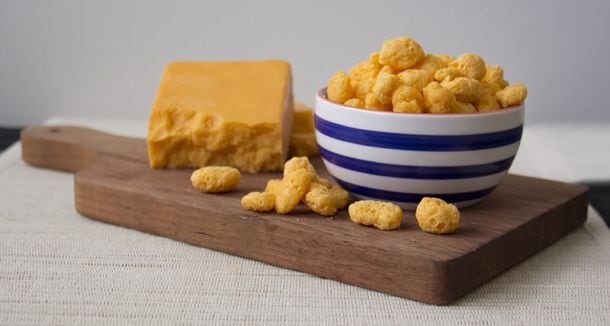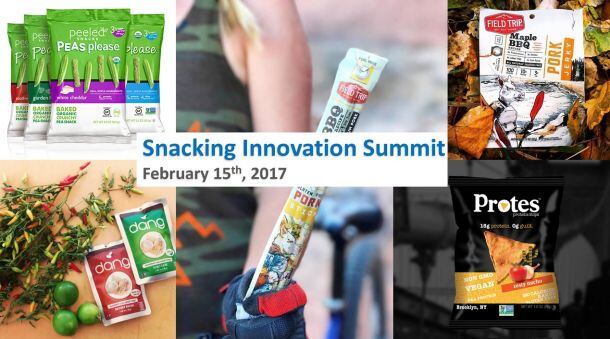Moon Cheese is just one of a series of new snacking concepts - from ‘crunchy’ yogurt to low-fat pulse-based crisps – made possible by EnWave’s REV technology, which dries foods using microwaves under a vacuum in a continuous process that is significantly faster and more cost-effective than freeze-drying, but still ensures products retain their flavor, color, aroma and nutrients, SVP business development, Brent Charleton, told FoodNavigator-USA.
“It’s faster and cheaper than freeze drying, with better end product quality than air drying or spray drying, and it can work across everything from fruits and vegetables, to spices and herbs, meat, petfood, dairy, pulses, pharmaceuticals and vaccinations.
“We’re working on a really wide range of new clean-label concepts, from puffs made from meat emulsions or fruit and vegetable purees, dairy inclusions, crunchy meat sausages and chips, you name it, the options are endless. Yes, you can make puffs using extrusion, but we’re using lower heat so you have superior nutrient retention and flavor profile.”
Novel snacking concepts
Other concepts under development with food industry partners include crunchy yogurt sticks and bites with probiotics, pet treats, and novel crunchy pea- and bean-based snacks with low or “negligible” oil/fat content (ie. that aren’t roasted or fried) using blanched pulses infused with flavors, he said.
“For yogurt snacks, we are talking about products that no one has ever seen before.
“We’ve done licensing deals with a large number of leading food companies including Milne Fruit Products (fruits/veggies), Hormel (meats), Gay Lea Foods (cheese snacks), Bonduelle (vegetables), Perdue Farms (pet food/treats), Merck (pharmaceuticals) and we’re doing research projects with companies including Jack Links, Ultima Foods, Ocean Spray and many more.”

"The key difference between our radiant energy vacuum (REV) and the other vacuum microwave technologies being developed is that we’ve established a continuous, large-scale and reliable way of homogeneously drying product loads."
Brent Charleton, SVP, business development, EnWave Corporation
Moon Cheese has performed extraordinarily well
He added: “In general, our approach is to license our technology to partners covering specific product applications and geographies and then in exchange for that exclusivity, they agree to pay us royalties on the wholesale price [of the products being manufactured] or on a throughput basis on the machinery.
“The point of Moon Cheese [which is owned by NutraDried LLP, in which EnWave has a 51% stake] was to showcase our large scale continuous technology in action to prospective partners and de-risk it for them, if you like, and luckily it has performed extraordinarily well,” he said.
"Revenues [at Moon Cheese] rose from CAN$2.6m in 2015 to CAN$6.1m in 2016, and we think it's a realistic goal to get to CAD $9m or CAD$10m in 2017."
EnWave has four technologies:
- nutraREV (designed for fruits, veg, spices, herbs, dairy, meat, seafood - where products is tumbled in large baskets rotating through the vacuum-microwave chamber);
- quantaREV (designed for fragile solid products, gels, liquids, or encapsulated products that are laid out in trays);
- powderREV (for temperature-sensitive bacteria, probiotics, enzymes etc);
- freezeREV (still in the pilot-stage, but designed for bio-materials such as vaccines and antibodies held in small vials at below freezing temperatures).
As radiant energy (microwaves) is applied in a vacuum, this reduces the atmospheric pressure and lowers the temperature at which moisture can efficiently be removed, minimizing the damage inflicted on foods and helping them retain color, flavor and nutrition.
A continuous, large-scale and reliable way of homogeneously drying product loads
But hasn’t microwave vacuum drying been around for a while? Yes, said Charleton, but EnWave stands apart because of its ability to execute the process reliably, at scale, to deliver homogeneous dehydration via a continuous process.
He added: “It’s an incredibly fast and efficient way of removing water from organic materials at controllable low temperatures.
“The key difference between our radiant energy vacuum (REV) and the other vacuum microwave technologies being developed is that we’ve established a continuous, large-scale and reliable way of homogeneously drying product loads. Other players in this space typically offer smaller scale batch units whereas we’ve got to the scale where we can incorporate entry and exit lock systems to continuously introduce and remove organic materials through the process."

Disruptive technology, novel products
He added: “We can also precisely control the moisture content of the final product, so users can determine the texture they want, whether it’s bone dry, or with more moisture.
“With fruits and veggies, we can produce similar products to freeze drying in terms of product quality and nutrient retention, at a fraction of the cost. In other cases, such as dairy, we can create completely new products [such as Moon Cheese], so it’s been very disruptive.
“It’s not easy to scale a vacuum microwave, because what tends to happen is that you get a concentration of energy in the vacuum chamber, which creates hotspots and in certain cases plasma discharge, making it unusable.”
Financial results
Vancouver-based EnWave - a spin off from the University of British Columbia led by food scientist Dr Tim Durance - posted revenues of CAN$14.9m in the year to September 30, 2016, compared with CAN$5.9m in the previous year. Net losses from continuing operations fell to CAN$1.8m in 2016 compared to CAN$5m in 2015.

Mini-meals, tapas-style eating, and hero SKUs: The trend towards continuous grazing throughout the day will create new ‘multi-temperature’ snacking opportunities for manufacturers as a ‘tapas-style’ approach to eating gains momentum, predicted panelists at our snacking innovation summit on Feb 15.
Register HERE (it's free) to watch all the sessions on demand.
